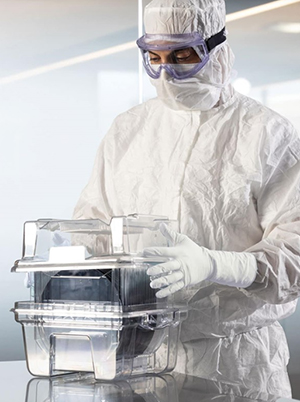The Crucial Role of Texture and Grip in Cleanroom Gloves
08 February 2024
Enhancing Cleanroom Safety: The Crucial Role of Texture and Grip in Gloves
 Picture this: you’re donned in a sterile cleanroom suit, navigating through a controlled environment where even a speck of dust is unwelcome. In such critical settings, every detail matters, and one of the heroes of cleanliness are cleanroom gloves. The importance of texture and grip in these gloves goes beyond mere convenience; it’s pivotal for safety and efficiency.
Picture this: you’re donned in a sterile cleanroom suit, navigating through a controlled environment where even a speck of dust is unwelcome. In such critical settings, every detail matters, and one of the heroes of cleanliness are cleanroom gloves. The importance of texture and grip in these gloves goes beyond mere convenience; it’s pivotal for safety and efficiency.Slipping on a pair of gloves that feel like a second skin, smooth, comfortable, and seemingly flawless, may sound appealing, however, in the realm of cleanrooms, the absence of texture can be disastrous. Smooth gloves lack the traction required to handle delicate instruments and materials without compromising their integrity. The introduction of texture provides a tactile advantage that can make or break the success of a critical operation.
Micro-texturing on the surface adds a layer of grip, allowing your workers to confidently manipulate tools and components. It’s like having a tiny, invisible ally ensuring that every movement is deliberate and controlled.
The significance of texture extends beyond preventing accidental slips. In an environment where precision is paramount, textured gloves offer a heightened sensitivity to touch. This enhanced tactile feedback is not just a luxury but a necessity, especially when working with minuscule components that demand surgical precision.
Now, let’s delve into the world of grip – a quality that transforms cleanroom gloves from mere accessories to indispensable tools. The grip in these gloves is not just about preventing dropping; it’s about ensuring a secure hold even when faced with challenging conditions. Whether handling a delicate microscope slide or intricate electronics, a reliable grip can be the difference between success and a catastrophic failure.
Consider this analogy: gripping a doorknob with wet hands versus dry hands. The difference is palpable. In cleanrooms, where the stakes are exponentially higher, a robust grip is the linchpin of success. The incorporation of advanced grip technology in cleanroom gloves is a testament to the commitment towards elevating safety standards.
In the fast-paced world of cleanroom operations, efficiency is non-negotiable. Textured and gripped gloves are the secret weapons in the arsenal of professionals striving for seamless workflows. Imagine a surgeon navigating a critical procedure – every movement, every touch is deliberate, guided by the assurance of a secure grip and enhanced tactile perception.
In conclusion, the next time you slip into a pair of cleanroom gloves, appreciate the subtle yet transformative power of texture and grip. These qualities are the unsung heroes of safety and precision in environments where compromise is not an option. The journey from smooth to textured gloves is not just a physical transition; it’s a paradigm shift towards a safer, more efficient, and reliable cleanroom experience.
At CES, we stock a full range of cleanroom gloves, including tacky and gripped gloves. The Halyard PUREZERO HG3 White Nitrile Glove is a perfect example of a high-quality glove with gripped fingertips, so you don’t have to compromise on protection or safety. PUREZERO* HG3 White Nitrile Cleanroom Gloves are ideal for cleanroom applications when handling delicate equipment in microelectronics, semiconductors, optics and non-sterile pharmaceutical and medical device manufacturing applications.
Maximum Particles
AQL 1.5 for pinholes
Accelerator, Latex, Powder and Silicone Free
30.5 (12″) Length with Beaded Cuff
Fingertip Thickness: 0.16 mm / 6 mil & Palm Thickness: 0.13 mm / 5 mil
Textured Fingertips and Palms with High Tack Grip
Antistatic
Recommended for use in ISO Class 3 cleanroom environments or higher.
Other Press Releases By This Company
- 14/03/2024 - Halyard Life Science Gloves & Our Sponsored Spin
- 08/12/2023 - Product of the Month – Micronclean IPA Tub Wipes
- 09/11/2023 - Micronclean VeriGuard Wipes Range
- 09/11/2023 - Micronclean CleanGuard Disinfectant Alcohol Range
- 06/11/2023 - How does Annex 1 affect you?
- 01/11/2023 - The Role of Neutral Detergents in Cleanrooms
- 01/11/2023 - The Role of PPE in the Pharmaceutical Industry
Released By
Critical Environmental Solutions Ltd




